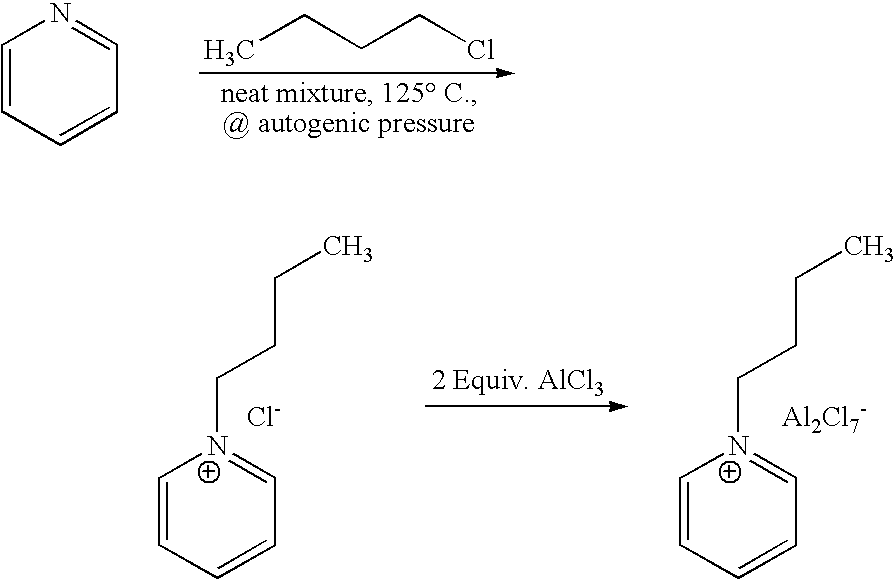Alkylation of olefins with isoparaffins in ionic liquid to make lubricant or fuel blendstock
a technology of isoparaffins and olefins, which is applied in the direction of hydrocarbon preparation catalysts, hydrocarbon oil treatment products, organic chemistry, etc., can solve the problems of air quality problems, undesirable olefinic double bonds, and problems in both fuels and lubricants, so as to increase the degree of branching and the molecular weight of the produ
- Summary
- Abstract
- Description
- Claims
- Application Information
AI Technical Summary
Benefits of technology
Problems solved by technology
Method used
Image
Examples
example 1
Preparation of Fresh 1-Butyl-Pyridinium Chloroaluminate Ionic Liquid
[0041]1-butyl-pyridinium chloroaluminate is a room temperature ionic liquid prepared by mixing neat 1-butyl-pyridinium chloride (a solid) with neat solid aluminum trichloride in an inert atmosphere. The syntheses of 1-butyl-pyridinium chloride and the corresponding 1-butyl-pyridinium chloroaluminate are described below. In a 2-L Teflon-lined autoclave, 400 gm (5.05 mol.) anhydrous pyridine (99.9% pure purchased from Aldrich) were mixed with 650 gm (7 mol.) 1-chlorobutane (99.5% pure purchased from Aldrich). The neat mixture was sealed and let to stir at 125° C. under autogenic pressure over night. After cooling off the autoclave and venting it, the reaction mix was diluted and dissolved in chloroform and transferred to a three liter round bottom flask. Concentration of the reaction mixture at reduced pressure on a rotary evaporator (in a hot water bath) to remove excess chloride, un-reacted pyridine and the chlorofo...
example 2
Alkylation of 1-decene with iso-butane
[0044]In a 300 cc Hastelloy autoclave, 100 gm (1.66 mol.) of liquefied isobutane and 10 gm (0.171 mol.) of 1-decene were added to 40 gm of 1-butyl-pyridinium chloroaluminate. Hydrochloric acid was used in the reaction as a promoter. The autoclave was sealed and the reaction was heated to 50° C. while stirring at ˜1000 rpm. The reaction was allowed to stir at 50° C. and at the autogenic pressure for 1 hour. Then, the stirring was stopped and the reaction was cooled to room temperature. The reaction was allowed to settle and the organic layer containing the feed and the products (sitting on the top of the ionic liquid layer) was separated from the ionic liquid by decantation. Excess isobutane was removed on a rotovap and the remaining oily liquid was analyzed by GC and GC-mass spectrometry. Table 1 below shows the GC analysis of the products. GC mass spectrometry of the largest peaks in the GC indicated the products to be saturated C14s (C14H30; M...
example 3
Alkylation of 1-decene with iso-pentane
[0047]Using the same procedure described above in Example 2, 13 gm of 1-decene was mixed with 101 gm of isopentane in 43 gm 1-butyl-pyridinium chloroaluminate. The reaction mixture (in autoclave) was heated to 50 degrees C. and stirred at 1000 rpm at autogenic pressure of 16 psi for 1 hr. The feed and the products were separated from the ionic liquid by decanting and the products (after removal of excess isopentane) were analyzed by GC and Mass Spectrometry. Table 2 below shows the GC analysis of the products. The major product appeared to be that of saturated C15s MW by GC-MS is 212. It also contained 14% of saturated C25 (MW=352).
[0048]
TABLE 2ProductsWt %Below C10s13C109.5C15s38.6C20s3C25s14C30s5.6others7.5
[0049]As in the alkylation with isobutane, alkylation of 1-decene with isopentane led to the formation of saturated C15s. The major peak by GC-MS analysis has a molecular weight of 212 (C15 MW=212.4). In addition to the formation of C15s, C...
PUM
| Property | Measurement | Unit |
|---|---|---|
| wt % | aaaaa | aaaaa |
| Bromine Number | aaaaa | aaaaa |
| Bromine Number | aaaaa | aaaaa |
Abstract
Description
Claims
Application Information
 Login to View More
Login to View More - R&D
- Intellectual Property
- Life Sciences
- Materials
- Tech Scout
- Unparalleled Data Quality
- Higher Quality Content
- 60% Fewer Hallucinations
Browse by: Latest US Patents, China's latest patents, Technical Efficacy Thesaurus, Application Domain, Technology Topic, Popular Technical Reports.
© 2025 PatSnap. All rights reserved.Legal|Privacy policy|Modern Slavery Act Transparency Statement|Sitemap|About US| Contact US: help@patsnap.com

